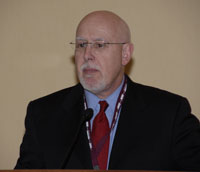 Dairy Markets Week in Review
Dairy Markets Week in Review
Cash block cheese ended the final week of January at $1.3325 per pound, down 1 1/2 cents on the week, but 9 1/4 cents above that week a year ago. Barrel closed Friday at $1.3750, up a penny on the week, and 16 1/2 cents above a year ago. 2 cars of block traded hands on the week and of 18 of barrel. The NASS-surveyed U.S. average block price slipped to $1.3090, down 2.2 cents. Barrel averaged $1.3337, unchanged from the previous week.
Butter closed Friday at $1.2250, down 4 1/2 cents on the week, and 2 1/4 cents below a year ago. 3 cars were sold. NASS butter averaged $1.2144, up 1.7 cents. NASS nonfat dry milk averaged $1.0872 per pound, down 0.3 cent. Dry whey averaged .4838, up 0.8 cent.
Provided courtesy of Dairyline.

 Woody Larson is a Florida dairyman who is attending the Cattle Industry Convention and he serves on the Beef Board.
Woody Larson is a Florida dairyman who is attending the Cattle Industry Convention and he serves on the Beef Board.
 The Beef Checkoff Dairy Producer Forum is underway here at the Cattle Industry Convention.
The Beef Checkoff Dairy Producer Forum is underway here at the Cattle Industry Convention. I’m attending the Cattle Industry Convention in Nashville, TN and blogging for the
I’m attending the Cattle Industry Convention in Nashville, TN and blogging for the  The
The